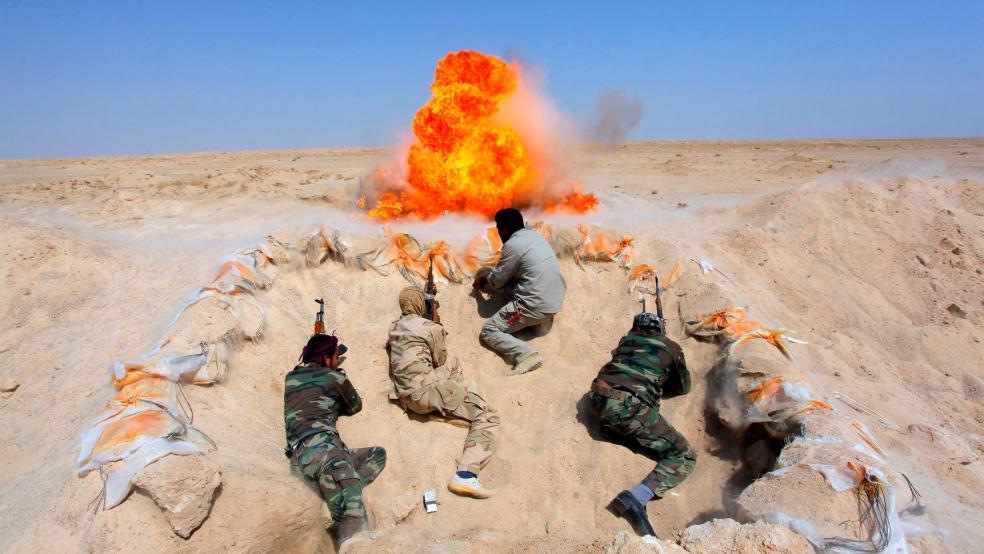Last Thursday was one of the worst days in the Middle East for a long time, from Iraq to Yemen.
ISIS had successfully attacked the city of al-Baghdadi in the western Anbar province Iraq after many failed efforts. This time, ISIS fighters managed to break in the city and control a major part of it. “A fierce attack on al-Baghdadi. Suicide belts and security checkpoints around the city were engaged,” said Saadon Shehan, a blogger from Anbar. “A breach has occurred from Albu Nimr to al-Baghdadi city center…. [ISIS] is now stationed in the police headquarters and the citizenship department building,” he later added.
Al-Baghdadi is strategically important. Nearby, an air base is located where no fewer than 300 US military service members are training and supporting the Iraqi government forces by coordinating air strikes. Last December, a similar attack had reportedly ended with the first ground fighting between ISIS and the US military.
Related: Kurds Are Close to Retaking Mosul from ISIS
As usual, ISIS is skilled in exploiting crises. As with every ISIS attack, this one’s timing and circumstances were carefully chosen. The attack coincided with President Obama’s request from Congress for approval of a war authorization to fight ISIS and was planned to embarrass Obama before his critics. Obama insisted on flexibility to employ US ground forces, prompting sharp Republican reactions.
ISIS wants to drag Americans into a ground fight to brag again that it is fighting the ‘crusader invader’ in the land of Islam. This will attract more fighters from all over the world. A US ground fight involvement will change the dynamic of the war. It is true a ground war will bring the heavy firepower of the US ground forces, but that will happen when ISIS chooses the time and the place, not the US.
In Anbar, this attack comes a week after a shooting incident of two Sunni men by allegedly Shiite militiamen. For a while, the Sunni tribes welcomed the Shiite militias’ help in the fight against ISIS. But this is no longer the case.
ISIS is also exploiting a long time crisis in Anbar. For months, the tribes cried for military aid. The Iraqi government sent few guns to help them. Mostly out of fear that the guns would fall into ISIS hands. Months ago, the town of Hit fell to ISIS, resulting in a massacre of hundreds of people. It could happened in al-Baghdadi now.
Related: Obama Crusades Video Boosts ISIS Propaganda Campaign
If al-Baghdadi falls, as many news organizations have already reported, Anbar could fall. Anbar is geographically Iraq’s largest province making about one third of the country. It borders six provinces, including Baghdad and 85 percent of the province is in ISIS hand now. The fall of Anbar means a huge step back that endangers Baghdad again and takes Iraq to the early day of the summer of 2014, when the very existence of the country was in doubt.
In Yemen, al-Qaeda has captured an entire army brigade in Shabwa province, southern Yemen. The 19 Yemeni army brigade, located in Bijan was overrun by al-Qaeda militants. Several soldiers were killed and many others were taken prisoners. It was reported that 30 tanks, 115 armored vehicles and 28 artillery batons have fallen to al-Qaeda.
Just two days ago, the US embassy in Yemen closed its doors and all US diplomats and Marines protecting them were evacuated. UK, France and Saudi Arabia followed later. The Houthi rebels who captured power in Yemen have taken the US embassy armor cars. A dispute is going on now over the US Marines personal weapons: did they leave their weapons or did they destroy them before the humiliating departure.
Yemen is home to al-Qaeda’s most dangerous branch. The last several attempts to attack the US homeland and the attack on the French magazine Charlie Hebdo in Paris were conducted by al-Qaeda in Yemen.
Just like ISIS, al-Qaeda in Yemen perfects the art of exploiting crises. In September, the Houthi Shiite rebels captured the capital Sanaa with the help of loyalists of Yemen’s former dictator Ali Abdullah Salih who was ousted after a revolution in 2012. Gradually, and province by province, the Houthis advanced in the ethnically divided Yemen between Sunnis and Shiites, provoking the Sunni tribes and creating a perfect opportunity to al-Qaeda to expand its presence.
Related: Kurdish Leader Doubts Obama Has an ISIS Plan
The final move was when they controlled the presidential palace in January, forcing the legitimate president to resign and dissolve parliament, and appointing a council to rule the country. “Yemen is collapsing before our eyes,” said Ban Ki Moon, the UN secretary general in an emotional appeal for help before the UN Security Council earlier this week.
Yemen’s descent into chaos is a gigantic step back in the war against terrorism. With the closure of the US embassy, one of the CIA’s most active stations was closed too, ending a decade long of field intelligence gathering and operations. The US drone strikes will be seriously weakened. The ousted president Abd Rabbuh Mansour Hadi was a partner in the war against al-Qaeda.
The Houthis are not only dangerous because they overthrew a legitimate government and they are taking Yemen into a civil war – a fourth in the Middle East after Iraq, Syria and Libya – but they are close to Iran as well. Copying Hezbollah and the Sadr movement in Iraq, they are supported by the Iranian revolutionary guard.
With their advance, the Sunni tribes in Yemen are looking to al-Qaeda as their protector.
Top Reads from The Fiscal Times:





